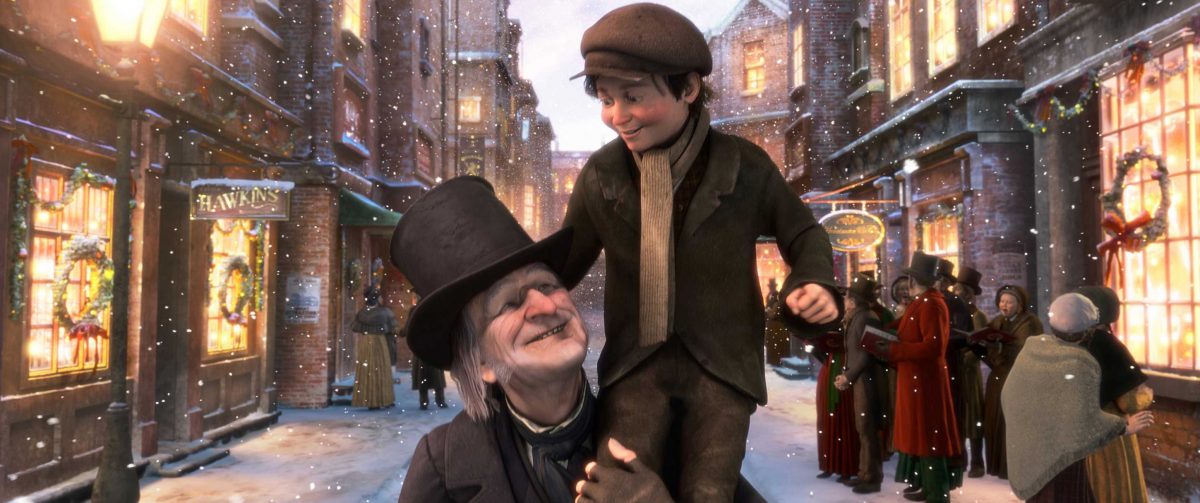 (2.5 / 5)
(2.5 / 5)
Christmas, as the saying goes, seems to come earlier every year.
As of my writing this, it is not yet mid November and already, en route to the cinema, the Staines council is decorating for the festive season. Also, for reasons unbeknownst to me, now is the time at which the powers that be have chosen to release the newest version of Charles Dickens’ beloved yuletide classic.
Now, to be entirely honest, I was more than prepared to truly dislike this film. I’ve seen innumerable adaptations of the book – which my Dad and I read every year – and it’s a difficult task at the best of times balancing fidelity to the text with cinematic innovation, regardless of all this digital chicanery (harumph!).
The story itself might be the best known in all of fiction. Who among us cannot say that Marley was dead to begin with, or, indeed, how exactly how dead? Is there anyone who does not the withering dismissal for which Scrooge was notorious? Indeed, it’s difficult enough to convey his transformation from that “squeezing, wrenching, grasping, scraping, clutching, covetous, old sinner” of lore to the benevolent figure who saves the life of only even with a flesh-and-blood actor the caliber of Patrick Stewart or George C. Scott.
However, Jim Carrey, while not an obvious pick for a more conventional retelling, is an inspired choice for Zemeckis’ animated protagonist. With the rubber-faced versatility of the man behind Ace Ventura and The Mask mapped onto the pinched and wizened mug of Mr. Scrooge, Carrey gives a strong and often surprisingly nuanced performance.
The same, unfortunately, cannot always be said for the rest of the cast. The various Ghosts, from the sickly green phantasm of Jacob Marley to the sinisterly cowled shadow of Christmas Yet to Come, also voiced by Carrey, are phantasmagorical delights, bringing Dickens’ macabre creations both vividly and loyally – if you’ll excuse the pun – to life.
The rest of the supporting cast, notably populated by Gary Oldman, Colin Firth, Bob Hoskins, and Robin Wright, do their best, but their character models, be it Scrooge’s eternally cheerful nephew Fred or his downtrodden but amiable employee Bob Cratchit, simply lack the same refinement.
While they may not suffer from that cardinal failure of performance capture, the phenomenon known as Uncanny Valley, they are simply not on screen long enough to form an attachment to them, as one might do if the living person behind the mask of animation was perhaps more in evidence. Tiny Tim, on the other hand, may be considered a success merely in that he does not come across as the creepily saccharine little gremlin I had feared (as in the George C. Scott production).
The film’s animation is simultaneously it’s greatest strength, allowing for the true wonder of Scrooge’s journey to seem truly magical: whether you’re flying through the night skies above Victorian London in a transparently-bottomed room or fleeing across cobbled streets from a demonic horse and carriage, it’s at these points that A Christmas Carol soars.
Having previously dismissed it as a gimmick worthy only of decade-old monstrosities, such as Jaws 3D or House of Wax (and at the time of writing still being a month away from the release of Avatar), recent releases have done much to renew my confidence in the anaglyphic image. Just as in Coraline before it, here the novelty is actually, well, refreshingly novel, doing much to immerse you in a world that could have proven intrusively artificial. Even so, these are but set pieces that should have provided a garnish to the full meal of the story’s emotional banquet.
The film inexplicably rushes through Scrooge’s history – his lonely childhood at boarding school, his merry apprenticeship with Hoskin’s bucolic Fezziwig, and his heart-breaking descent into penny-pinching parsimony – which diminishes the joy of his eventual salvation. Carrey alone sells Scrooge’s giddy exuberance, a stark contrast to his earlier meanness of spirit.
Despite its essential shallowness, Zemeckis’ adaptation of the classic story is as visually opulent A Christmas Carol as any committed to celluloid and possesses another earnest glee to remove any cynicism that may surround it. After all, now (I should say, then) is the time for charity and goodwill towards all men, even if the day itself is still a while off.
In retrospect, I’d wait a little closer to December 25nd to pay a visit to your local metroplex, but – though if you’re not a fan of the book this version will do little to rectify that – if the spirit seizes you, my recommendation is to go with it.
